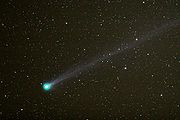
Comet Pojmanski
Encyclopedia
Comet Pojmański is a non-periodic comet discovered by Grzegorz Pojmański
on January 2, 2006 and formally designated C/2006 A1. Pojmański discovered the comet at Warsaw University Astronomic Observatory using the Las Campanas Observatory
in Chile
as part of the All Sky Automated Survey
(ASAS). Kazimieras Cernis at the Institute of Theoretical Physics and Astronomy at Vilnius
, Lithuania
, located it the same night and before the announcement of Pojmański's discovery, in ultraviolet images taken a few days earlier by the SWAN instrument aboard the SOHO satellite. A pre-discovery picture was later found from December 29, 2005.
At the time of its discovery, the comet was roughly 113 million miles (181 million kilometers) from the Sun. But orbital elements indicated that on February 22, 2006, it would reach perihelion at a distance of 51.6 million miles — almost half the Earth's average distance from the Sun.
The comet moved on a northward path across the night sky, and reached maximum brightness around the beginning of March. Comet Pojmański reached the very fringe of naked-eye visibility at about magnitude
5, and was best visible through binoculars
or a telescope
. It could be found in the dawn sky within the constellation Capricornus
, close to the horizon in the northern hemisphere, during late February, but viewing circumstances became better for the northern hemisphere as the comet departed southern skies and continued north.
 By early March, the comet was located in Aquila
By early March, the comet was located in Aquila
, the Eagle
, and by March 7 was located in the constellation Delphinus
, the Dolphin
.
Comet Pojmański brightened more than initially estimated, perhaps due to over-cautious estimates by astronomers. It had previously been estimated to reach a maximum brightness of around 6.5 magnitude, but became considerably brighter.
During the comet's appearance, it sported a tail of three to seven degrees (six to fourteen times the apparent lunar diameter) and a coma
of up to about 10 arcseconds.
Grzegorz Pojmanski
Dr Grzegorz Pojmański , Polish astronomer, worker of Warsaw University Astronomical Observatory, Poland. In 1997 Pojmański together with professor Bohdan Paczyński implemented the project All Sky Automated Survey . With the ASAS Alert System Pojmański discovered two new comets: C/2004 R2 and...
on January 2, 2006 and formally designated C/2006 A1. Pojmański discovered the comet at Warsaw University Astronomic Observatory using the Las Campanas Observatory
Las Campanas Observatory
Las Campanas Observatory is an astronomical observatory owned and operated by the Carnegie Institution for Science It was established in 1969 and remains the primary observing site of that institution. The headquarters is located in La Serena, Chile and the observatory is in the southern Atacama...
in Chile
Chile
Chile ,officially the Republic of Chile , is a country in South America occupying a long, narrow coastal strip between the Andes mountains to the east and the Pacific Ocean to the west. It borders Peru to the north, Bolivia to the northeast, Argentina to the east, and the Drake Passage in the far...
as part of the All Sky Automated Survey
All Sky Automated Survey
The All Sky Automated Survey is a Polish project implemented on 7 April 1997 to do photometric monitoring of approximately 20 million stars brighter than 14 magnitude all over the sky. The automatic telescopes discovered two new comets in 2004 and 2006...
(ASAS). Kazimieras Cernis at the Institute of Theoretical Physics and Astronomy at Vilnius
Vilnius
Vilnius is the capital of Lithuania, and its largest city, with a population of 560,190 as of 2010. It is the seat of the Vilnius city municipality and of the Vilnius district municipality. It is also the capital of Vilnius County...
, Lithuania
Lithuania
Lithuania , officially the Republic of Lithuania is a country in Northern Europe, the biggest of the three Baltic states. It is situated along the southeastern shore of the Baltic Sea, whereby to the west lie Sweden and Denmark...
, located it the same night and before the announcement of Pojmański's discovery, in ultraviolet images taken a few days earlier by the SWAN instrument aboard the SOHO satellite. A pre-discovery picture was later found from December 29, 2005.
At the time of its discovery, the comet was roughly 113 million miles (181 million kilometers) from the Sun. But orbital elements indicated that on February 22, 2006, it would reach perihelion at a distance of 51.6 million miles — almost half the Earth's average distance from the Sun.
The comet moved on a northward path across the night sky, and reached maximum brightness around the beginning of March. Comet Pojmański reached the very fringe of naked-eye visibility at about magnitude
Magnitude (astronomy)
Magnitude is the logarithmic measure of the brightness of an object, in astronomy, measured in a specific wavelength or passband, usually in optical or near-infrared wavelengths.-Background:...
5, and was best visible through binoculars
Binoculars
Binoculars, field glasses or binocular telescopes are a pair of identical or mirror-symmetrical telescopes mounted side-by-side and aligned to point accurately in the same direction, allowing the viewer to use both eyes when viewing distant objects...
or a telescope
Telescope
A telescope is an instrument that aids in the observation of remote objects by collecting electromagnetic radiation . The first known practical telescopes were invented in the Netherlands at the beginning of the 1600s , using glass lenses...
. It could be found in the dawn sky within the constellation Capricornus
Capricornus
Capricornus is one of the constellations of the zodiac; it is often called Capricorn, especially when referring to the corresponding astrological sign. Its name is Latin for "horned male goat" or "goat horn", and it is commonly represented in the form of a sea-goat: a mythical creature that is half...
, close to the horizon in the northern hemisphere, during late February, but viewing circumstances became better for the northern hemisphere as the comet departed southern skies and continued north.

Aquila (constellation)
Aquila is a stellar constellation. Its name is Latin for 'eagle' and it is commonly represented as such. In mythology, Aquila was owned by the Roman god Jupiter and performed many tasks for him....
, the Eagle
Eagle
Eagles are members of the bird family Accipitridae, and belong to several genera which are not necessarily closely related to each other. Most of the more than 60 species occur in Eurasia and Africa. Outside this area, just two species can be found in the United States and Canada, nine more in...
, and by March 7 was located in the constellation Delphinus
Delphinus
Delphinus is a constellation in the northern sky, close to the celestial equator. Its name is Latin for dolphin. Delphinus was one of the 48 constellations listed by the 2nd century astronomer Ptolemy, and it remains among the 88 modern constellations recognized by the International Astronomical...
, the Dolphin
Dolphin
Dolphins are marine mammals that are closely related to whales and porpoises. There are almost forty species of dolphin in 17 genera. They vary in size from and , up to and . They are found worldwide, mostly in the shallower seas of the continental shelves, and are carnivores, mostly eating...
.
Comet Pojmański brightened more than initially estimated, perhaps due to over-cautious estimates by astronomers. It had previously been estimated to reach a maximum brightness of around 6.5 magnitude, but became considerably brighter.
During the comet's appearance, it sported a tail of three to seven degrees (six to fourteen times the apparent lunar diameter) and a coma
Coma (cometary)
frame|right|The [[153P/Ikeya-Zhang|comet Ikeya-Zhang]] exhibiting a bright, condensed coma In astronomy, a coma is the nebulous envelope around the nucleus of a comet. It is formed when the comet passes close to the Sun on its highly elliptical orbit; as the comet warms, parts of it sublimate...
of up to about 10 arcseconds.

